Moral Judgments of High-School Students
G. S. Slavens and Albert P. Brogan
I
In the last few years three articles have been published in this Journal,[1] in which the moral judgments of university students were studied both at the University of Texas and at several northern universities. Those articles dealt with sixteen practices, which were named by the students and then ranked according to comparative value and comparative frequency of occurrence.
The present article reports an extension of the previous work in statistical ethics into the field of the high school. The earlier work with university students attempted both to give a description of their moral judgments and to use this material for verification of certain philosophical theories about the nature and objectivity of moral valuations. The present work with high-school students carries on these general purposes of study, but adds the following special purposes. In the first place, we desire to know if younger students in the high schools have moral judgments which are as definite as the judgments of university students. In the second place, we de-sire to see how the general tendencies of the high-school judgments, however definite or indefinite they may be, compare with the university judgments. Finally, we wish to see what light our study of high-school judgments about moral matters may throw on the much-discussed problem of moral education in the high school.
II
For the purposes of this experiment, investigations were made in the Senior High School of Austin, Texas, and the Main Avenue Senior High School of San Antonio, Texas. In
( 58) each case, the senior high school includes the last three grades, that is, the ninth, tenth, and eleventh. The students, there-fore, are approximately from fourteen to seventeen years of age.
San Antonio is the largest city in Texas, with a population of about two hundred thousand. It does not have any university or large college. It has many Mexican citizens, but few of their children go to the high school studied. Austin is the capital and the seat of the state university. Its population is not over fifty thousand. It is much stricter in such matters as "blue laws" than is San Antonio. The Austin high school is strongly influenced by the university in such matters as student life, teaching practice, etc. Accordingly, we may say that the two high schools studied are markedly different in their urban environment.
During the academic year 1925-26, studies were made of approximately two hundred boys and two hundred girls in each high school. The university list of sixteen practices was used, with the omission, at the suggestion of the high-school authorities, of the topic "sex irregularity." This omission is a loss, though it is probable that this topic would have been con-fusing in the high school unless it were more carefully defined than was necessary in the university. The list of the remaining fifteen practices may be seen in any of the following tables.
For the sake of simplicity, the previous university studies in what may be called "double standards" were omitted. The two main problems to be studied were thus the ranking of the fifteen practices in order of comparative value or "worseness" and in order of comparative frequency. The comparative value concerned human beings in general, but for the frequency, each sex was asked to rank the frequency among members of its own sex in the high schools. Thus we get for each of the two high schools the following six results : (1)Boys' rank about general worseness. (2) Girls' rank about general worseness. (3)Boys' rank about comparative frequency among
( 59) high-school boys. (4) Girls' rank about comparative frequency among high-school girls. (5) Boys' judgment as to whether each practice is more frequent among high-school boys than girls, etc. (6) Girls' judgment as to whether each practice is more frequent among high-school boys than girls, etc.
Approximately one hundred boys and one hundred girls in each high school filled out the blanks about comparative value, and another hundred of each sex in each high school filled out the blanks about comparative frequency. The blanks were not to be signed, though the sex was to be indicated in each case. The groups of students were so selected that they gave a "fair sample" of the student body in each high school.
III
Table A gives the results for the boys and the girls in both high schools concerning the question of comparative value or worseness. The rankings are based on arithmetical averages in each case. In column I, the practices are listed. In columns 2 and 3, the rankings of the San Antonio and Austin boys are given. In columns 4 and 5, the rankings of the San Antonio and Austin girls are given. In columns 6 and 7, the former rankings by many hundreds of men and women at the University of Texas in the years 1919-21 are given. Columns 8 and 9 repeat the rankings by University of Texas students, but for the year 1923-24.
A glance at Table A reveals the high degree of uniformity among all the rankings. The different coefficients of correlation are given in Table B. For each coefficient, its standard error is given. Most of the coefficients of correlation are above ninety. In other words, there is usually less than 10 per cent of difference among these ranks. With such high uniformity, it is useless , to attempt any profound explanation for what slight differences there are. Among the high-school ranks, the only large difference concerns smoking. But an examination
( 60) of the arithmetical averages (not here printed) on which these ranks are based shows that the difference is really very slight
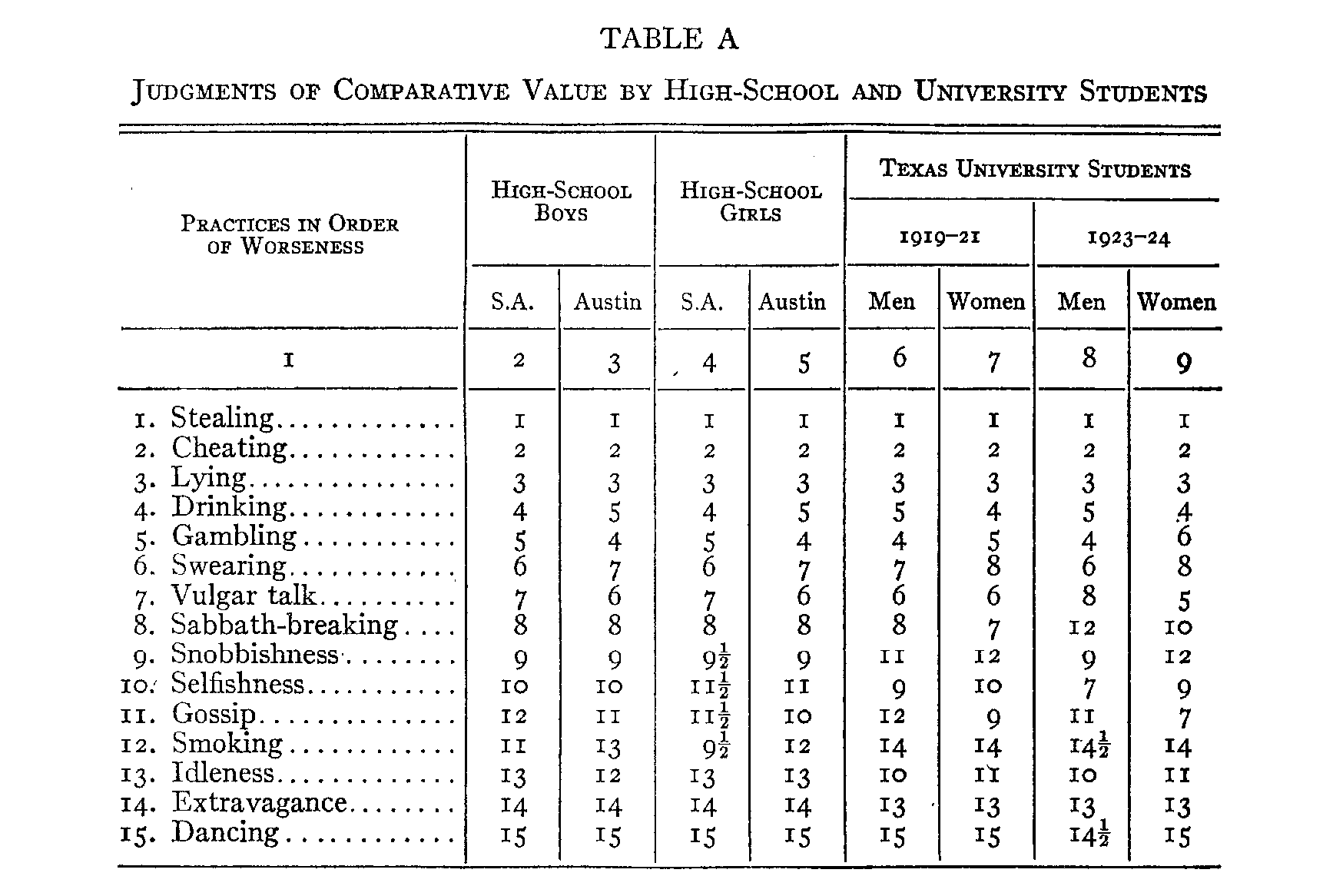
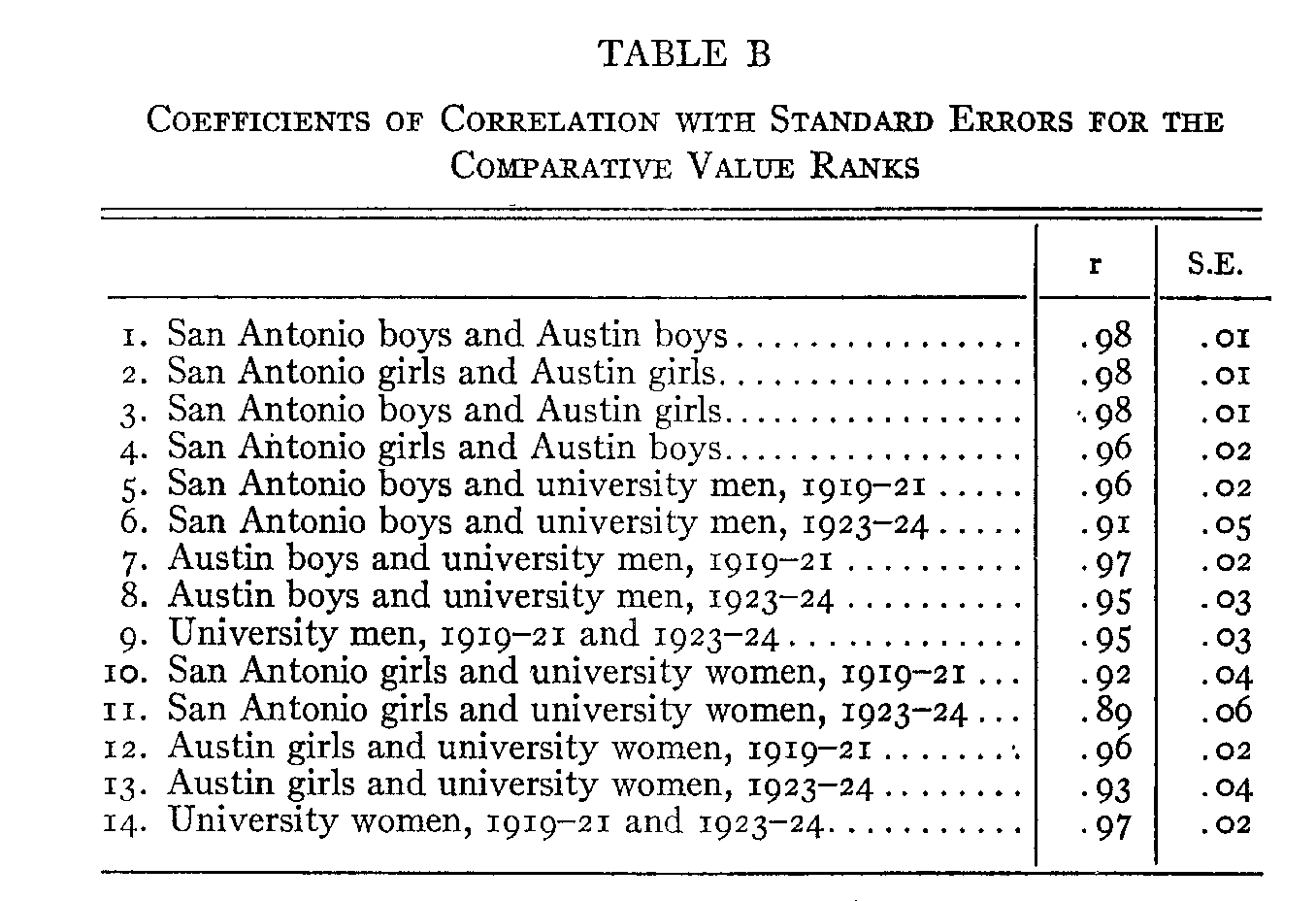
and is caused by the "bunching" of four practices in the ranks by the San Antonio girls. When the high-school figures are
( 61) compared with the university figures for either period, there are slight differences about snobbishness, selfishness, smoking, and idleness. The respective reasons for these differences probably involve the greater democracy of high schools, more maturity about self-interest, popular teaching about smoking by children, and greater temptation to loaf when away from parental control. But with such slight differences, these reasons should not be overemphasized.
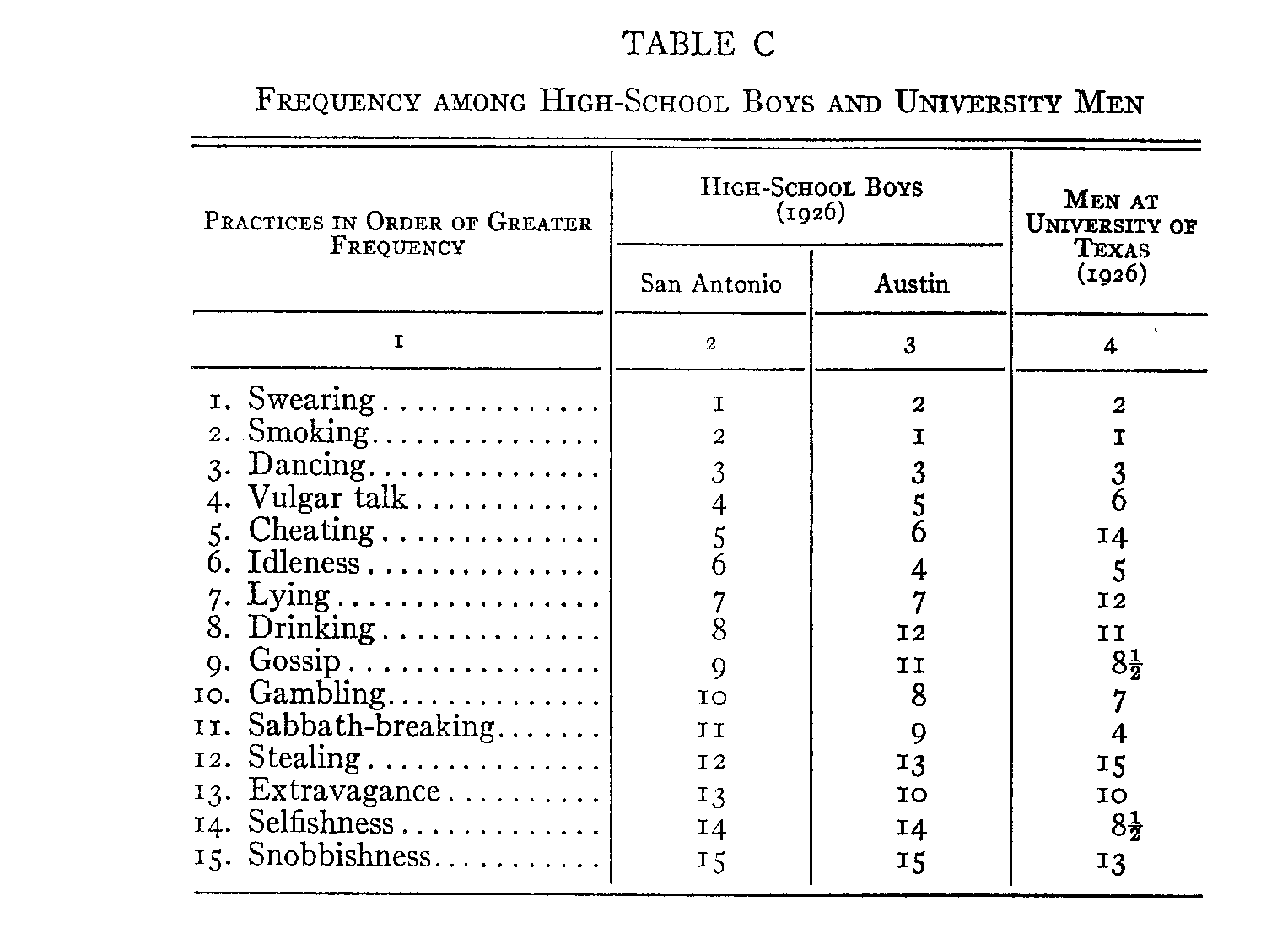
The quartile deviation will be shown in Table H for both comparative value and comparative frequency.
IV
Table C shows the comparative frequency in 1926 for the boys in the San Antonio and Austin high schools and for the men in the University of Texas. Table D shows the similar facts for the girls and women. Table E shows the coefficients of correlation for these frequency ranks, but adds the correlations of the high-school students in 1926 with the university
( 62) students in 1919-22 in larger numbers. The correlations between the two sexes will be considered later.
The details of the frequency ranks call for little comment. The outstanding difference concerns cheating. In the high schools, cheating ranks fifth or sixth in both sexes. In the university, cheating is eleventh among the women and fourteenth among the men. The figures for the men and women at the
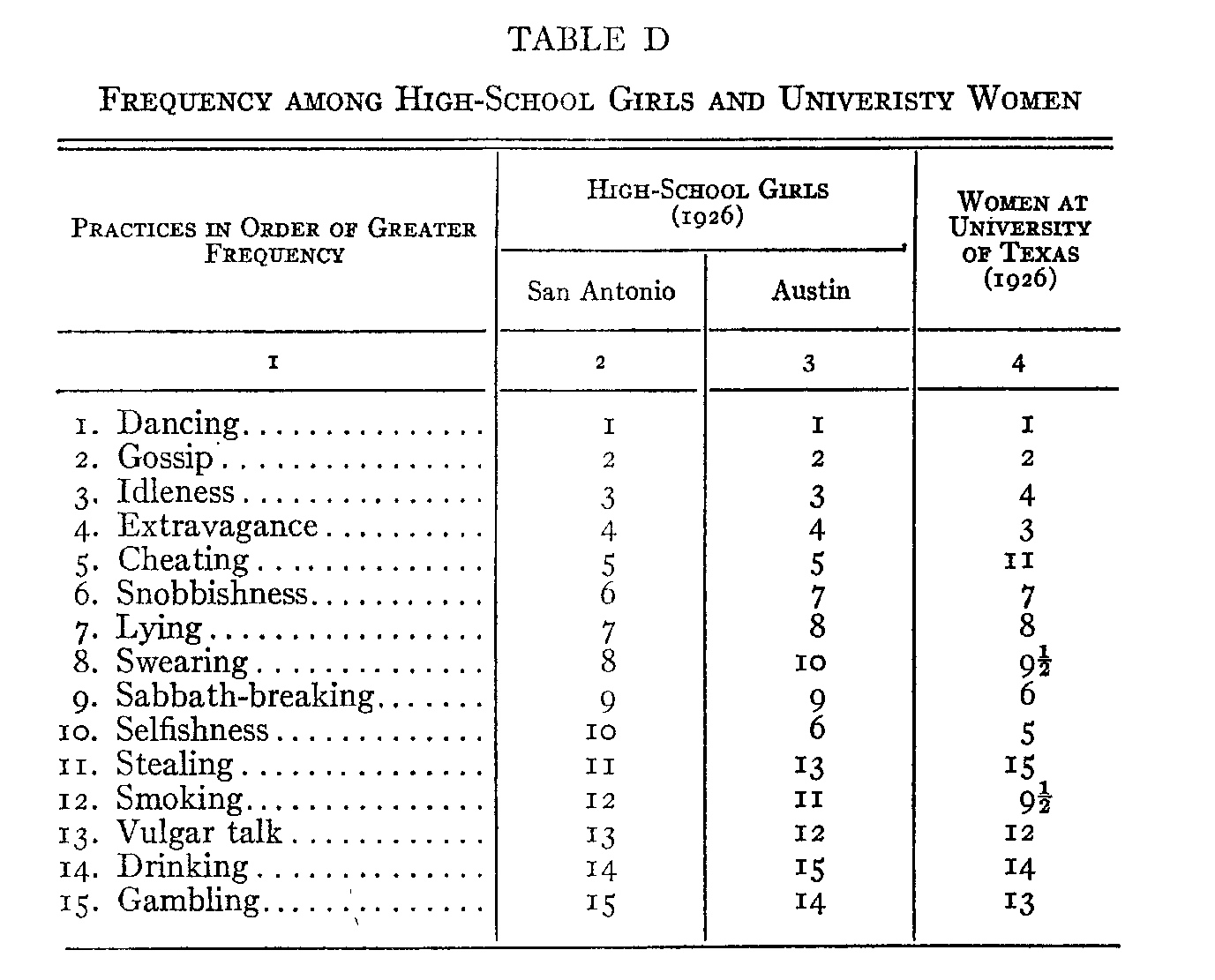
university might seem to indicate that there is more cheating among the women than among the men, but this difference has been shown elsewhere [2] to be caused by the infrequency of certain other practices among the university women. It seems improbable that there is any such explanation for the difference between the high school and the university. Such a big difference in rank seems to indicate a real difference in frequency. How can it be explained? There are two factors to be considered. One factor is that the university students are older and more mature. The other factor is that the high
( 63) schools have a so-called proctor system for examinations, while the University of Texas has an honor system that is a form of student self-government. There does not seem to be any way to estimate the relative importance of these two factors on the basis of our present data.
The other differences in the ranks are smaller ones. The difference between drinking among the San Antonio boys on the one hand and the Austin boys and university men on the other hand should be noticed. The differences about selfishness may easily be due to different interpretations of the topic,
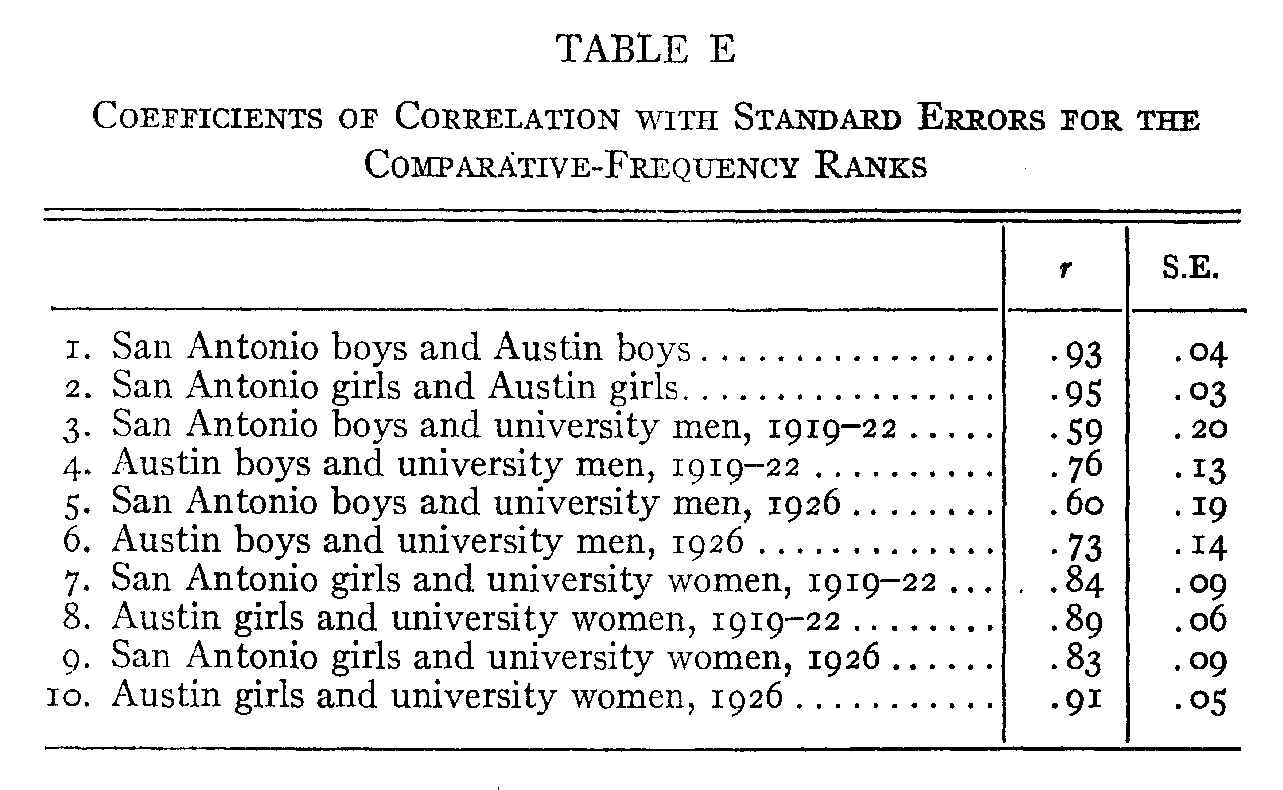
which is perhaps concerned with a trait rather than a practice. The difference in regard to Sabbath-breaking is what might be expected.
The coefficients of correlation in Table E present a considerable range. When the boys in the two high schools are compared, their correlation is plus .93. For the girls the figure is .95. But when the high-school students are compared with the university students, there are much lower correlations, plus .59 to .76 for the men, and plus .83 to .91 for the women. These correlations are still fairly high, but much lower than any previous correlations about these topics. However, it should be remembered that a large amount of this difference in the correlations is due to the one topic of cheating.
( 64)
V
So far our study of the frequency of practices in the high schools has given two main ranks, a rank for frequency among the boys and a rank for frequency among the girls. But we have not yet had any material for tying these two ranks together. In the abstract we might consider the possibility that every practice of one sex was more frequent than any practice of the other sex. Table F shows the results of a separate
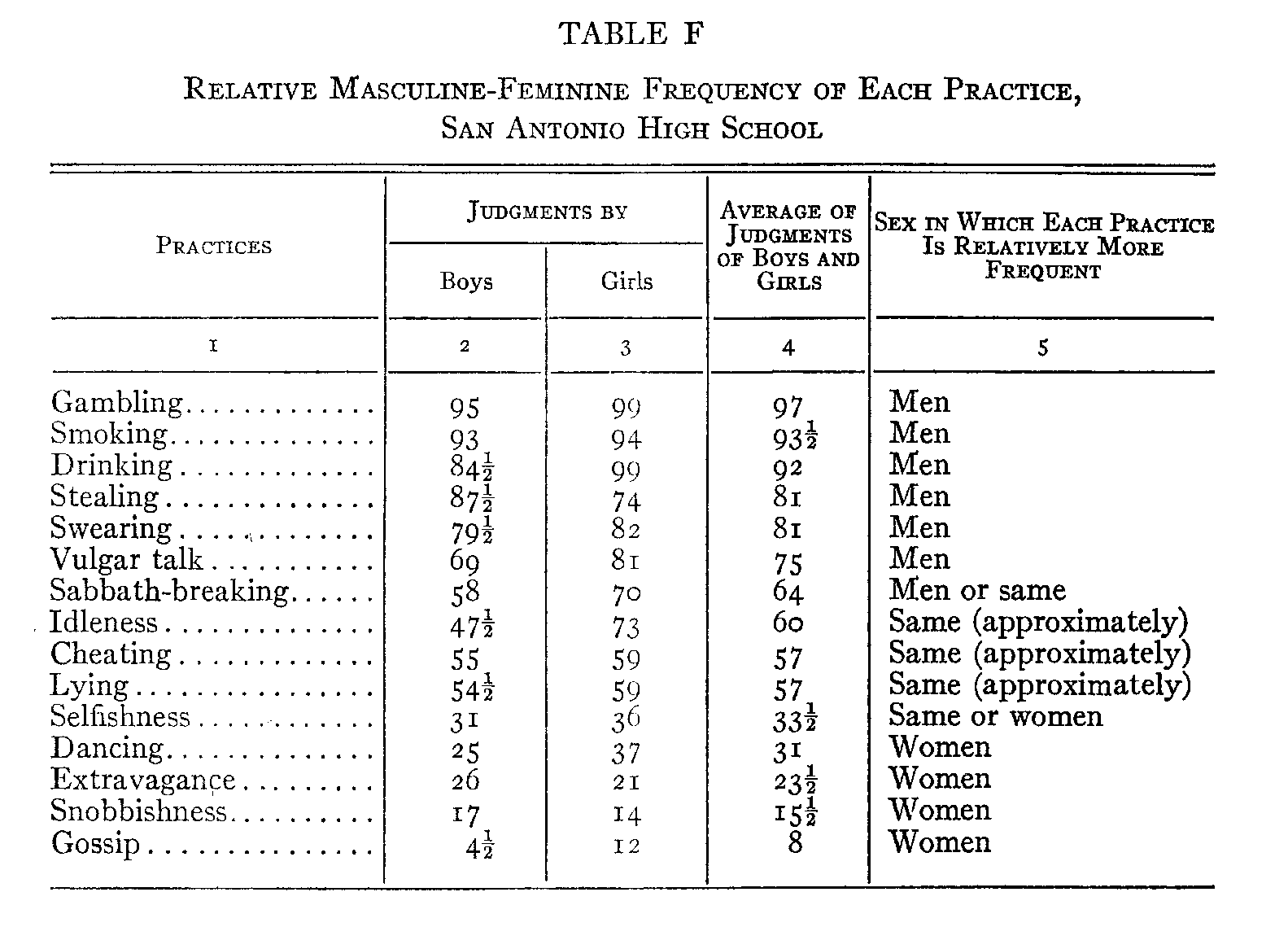
study as to whether each practice is more frequent among the boys, or more frequent among the girls, or approximately the same in frequency. In order to save space, only the figures for the San Antonio high school are given. The figures for the Austin high school are almost identical in their main results. The methods by which these figures were obtained and reduced to simple forms have been explained elsewhere,[3] and need not be repeated here.
In column 1, the practices are arranged in the order of
( 65) greater frequency among boys rather than among girls. Column 2 gives the boys' votes and column 3 gives the girls' votes. Column 4 gives the average of the votes by the girls and by the boys. Column 5 gives the classification of the practices ac-cording to the results of column 4. Those practices for which the percentages run from 66 to 100 are classed as more frequent among the boys. Those practices for which the percent-ages run from 33 to 66 are classed as approximately the same in frequency. Those practices for which the percentages run from o to 33 are classed as more frequent among the girls. There are two practices on the border lines. Sabbath-breaking, with a figure of 64, is barely within the "same" group. The difference between the boys and the girls here is striking. Selfishness, with a figure of about 33, is almost exactly on the border line. Since the Austin students put it well within the lower group, and since the university students put it there, it should be classified in the lower group. So we get the results as follows: Gambling, smoking, drinking, stealing, swearing, and vulgar talk are more frequent among the boys than among the girls. Gossip, snobbishness, extravagance, dancing, and selfishness are more frequent among the girls. Sabbath-breaking, idleness, cheating, and lying are about the same in frequency in the two sexes.
Corresponding figures for the university students give exactly the same classification of these practices as to relative frequency among the sexes.[4]
VI
We are now in a position to tie together the rank about frequency among the boys and the rank about frequency among the girls. Table G gives the results of this study for the San Antonio high school only. In column I the practices are arranged according to frequency among the boys. In column 4 the practices are arranged according to frequency among the girls. Column 2 states by abbreviations whether
( 66) each practice listed in column I is more frequent among the boys (M) or more frequent among the girls (W) or about the same in frequency (S) . Column 3 does the same work for the practices as listed in column 4. In reading these tabulations, read straight across when S occurs; upward when M occurs; and downward when W occurs.
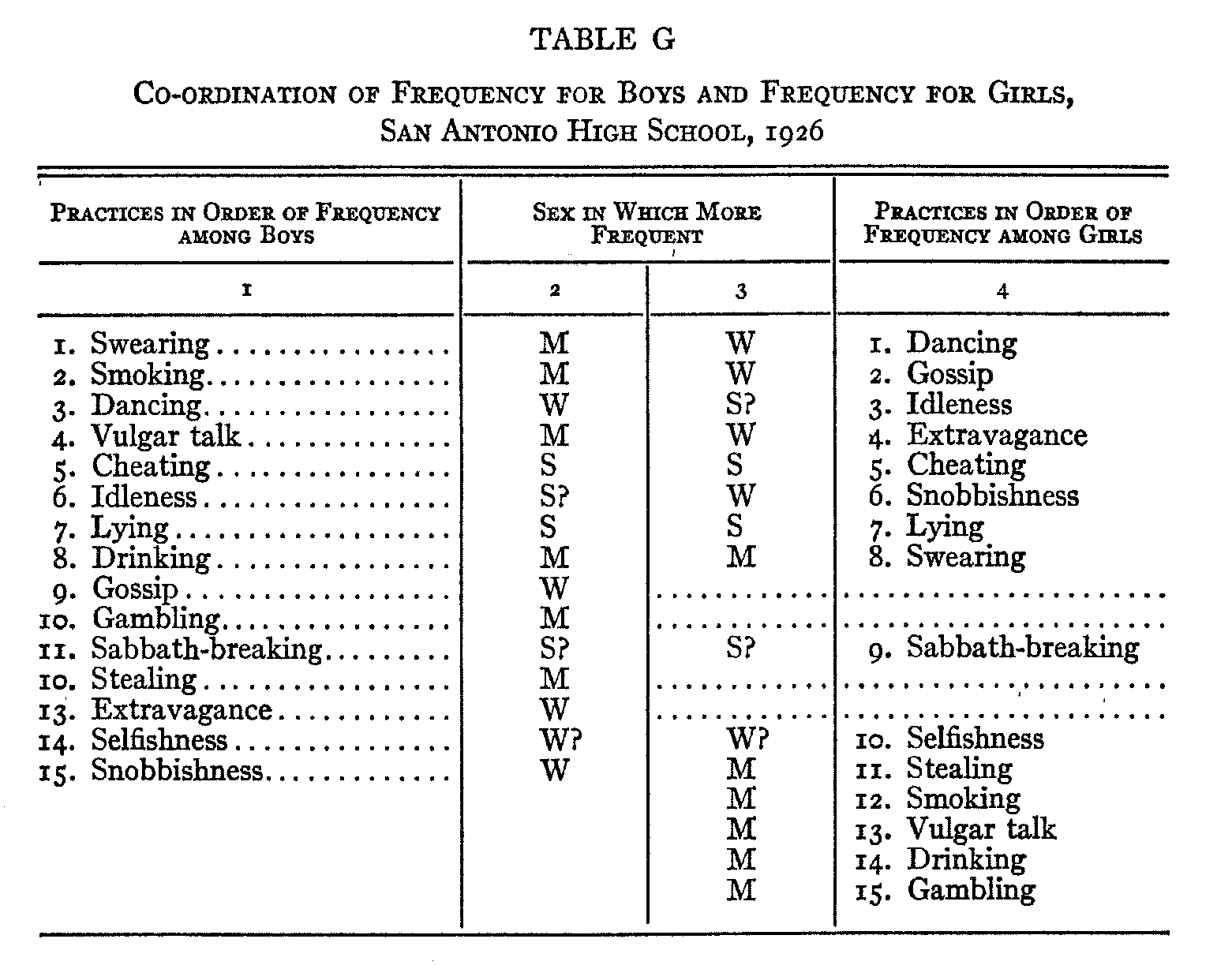
There is one contradiction in this table, about idleness. It is ranked as less frequent than cheating among the boys; cheating among the boys is the same in frequency as cheating among the girls; cheating among the girls is less frequent than idleness among the girls. Despite these facts, idleness is ranked as the same in frequency among the two sexes. This contradiction is similar to the one which was found among university students, not about relative frequency, but about the comparative value of practices among men and among women.[5]
( 67)
It is possible that this contradiction about the rank of idleness would disappear if we took the votes of each sex about each sex, in place of the votes of the boys about the boys and the girls about the girls. However, similar contradictions in the figures for the university students about the so-called "double standards" did not disappear under those conditions. Moreover, one slight contradiction ,in this elaborate table should not be overemphasized. There might be much more contradiction. In fact, one might have expected much more, when the intricacy of the table is considered.
VII
We have not yet considered the coefficients of correlation for the frequency ranks among the two sexes. When the frequency for the boys in San Antonio is compared with the frequency for the girls there, we find that the coefficient of correlation is +.04, with a standard error of .25. The corresponding figure for the students at the University of Texas in 1919-22 was +.03.
The comparison of the frequency ranks and the value ranks gives interesting results. When the students in the two cities are averaged together we get the following results: The boys' rank about greater worseness and the boys' rank about greater frequency among the boys have a coefficient of correlation of ----.13, with a standard error of .26. The corresponding figure for the girls is -.54, with a standard error of .19. In other words, there is approximately a zero correlation between frequency and value for the boys, but approximately a -.50 per cent correlation for the girls.
VIII
Table H shows the quartile deviations or dispersions for both the value ranks and the frequency ranks in the San Antonio students. It is obvious at first glance that the dispersions for the value ranks are smaller than the dispersions for the frequency ranks. In the value dispersions, the average of
( 68) the boys for all the practices is 1.93, the average of the girls is 1.75. In the frequency ranks, the average of the boys is 3.13; the average of the girls is 2.86. When the average quartile for the value ranks in the high school is compared with quartiles for the university ranks, the figures are approximately the same[6] But the university quartiles for the frequency ranks are smaller: 2.56 for the men, and 1.78 for the women.[7]
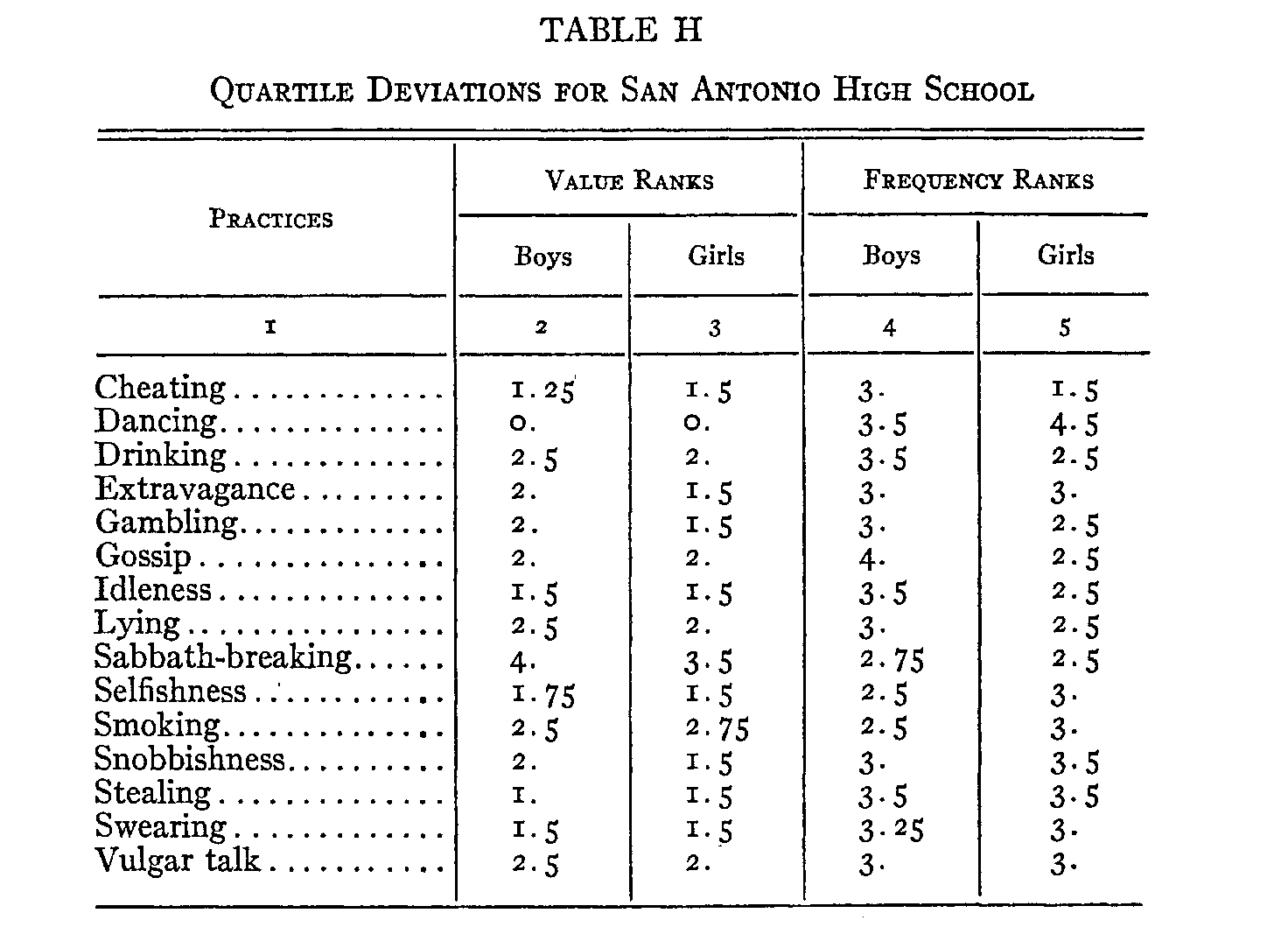
IX
Our conclusions can be very short. There is no need to re-peat here the remarks in the earlier articles on statistical ethics concerning the ethical and philosophical significance of these studies. In regard to what is peculiar to this study in the moral judgment of high-school students, the following points may be made.
1. The ranks by high-school students concerning comparative value are very uniform among themselves and very
( 69) similar to the university ranks. The moral judgments in the high schools are fully as definite and precise as those in the university.
2. The frequency ranks in the high schools are very similar when the boys are compared with the boys or the girls with the girls.
3. The frequency ranks in the high schools are only moderately similar to the frequency ranks in the university, but the differences seem to be open to reasonable explanations.
4. In the high schools, the frequency between the sexes has the same correlation, approximately zero, that it has in the university.
5. In the high schools, the correlation between comparative value and comparative frequency is approximately -.50 for the girls, which is about the figure for both men and women in the university. But the figure for boys in high school is a much smaller negative correlation.
6. The facts which this paper has collected may be studied for their own sake as interesting parts of contemporary morality, or they may be studied in relation to university morality. But perhaps their most significant use is in relation to the problem of moral education. We have had an immense literature about the question of moral education in schools, especially in the high schools. Usually that literature has been purely speculative or theoretical. Surely the discussion of the place of moral education in the high schools should be based upon the objective study of such facts as we have collected here. Further studies should be made before final conclusions are made. But surely it is obvious, even on the basis of the present paper alone, that the moral ideas and conduct of high-school students are very similar to the moral ideas and con-duct of university students. This similarity may not settle the problem of moral education, but it is at least an indispensable bit of evidence concerning this problem.
UNIVERSITY OF TEXAS